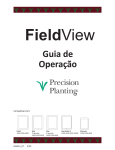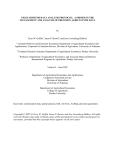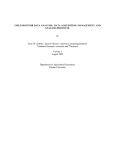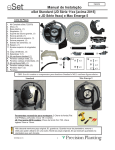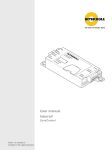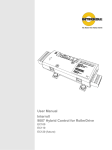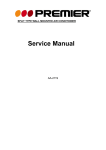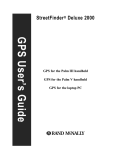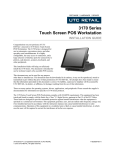Download RowFlow Operators Manual
Transcript
RowFlow Operators Manual 955128_02 12/10 This Page Intentionally Left Blank 955128_02 12/10 2 Precision Planting, Inc. 23207 Townline Road Tremont, IL 61568 ph. (309) 925-5050 fax. (309) 925-5029 [email protected] [email protected] Precision Planting Warranty & Liability Policy (Revision effective 7-1-10) Warranties, Disclaimers, and Limitation of Remedies: These terms and conditions represent the entire agreement between the parties hereto an there are no collateral, oral, or other agreements or understandings, unless expressly stipulated. Precision Planting warrants that all Precision Planting products, equipment and merchandise are free from defects in material and workmanship. The term of the express warranty recited herein shall be limited to one (1) year from the date of sale by Precision Planting. This warranty shall only extend to the dealer if this warranty is properly presented to Customer. With respect to 20/20 SeedSense, AirForce and RowFlow, the express warranty recited herein shall only apply if such products are properly registered by the Customer. These terms and conditions represent the entire agreement between the parties hereto and there are no collateral, oral, or other agreements or understandings, unless expressly stipulated. The express warranty recited herein does not extend to any costs or damages other than one of the following, which Precision Planting shall elect at its sole discretion: replacement, repair, or refund of the purchase price. Precision Planting makes no other warranty of any kind whatsoever, express or implied. ANY EXPRESS OR IMPLIED WARRANTIES OF MERCHANTABILITY OR FITNESS FOR A PARTICULAR PURPOSE ARE HEREBY DISCLAIMED BY PRECISION PLANTING. THERE ARE NO WARRANTIES THAT EXTEND BEYOND THE DESCRIPTION ON THE FACE HEREOF. Precision Planting is NOT LIABLE FOR CONSEQUENTIAL DAMAGES of any nature whatsoever, including without limitation lost yield, replanting cost, supplies or other expenses. Precision Planting is NOT LIABLE FOR INCIDENTAL DAMAGES of any nature whatsoever, including without limitation diagnostic and installation expenses, travel expenses, and shipping expenses. The limitations of remedy recited herein apply to any action by the Customer whether or not such action is based in warranty. Some states or jurisdictions do not allow the exclusion or limitation of implied warranties, incidental damages or consequential damages; so the above limitations or exclusions may not apply to you. Liability: Customer assumes all liability for damages from accidents caused by or incurred in the use of transportation of said equipment. Customer agrees to indemnify and hold harmless the said Precision Planting, its officers, agents, and employees from any and all damages and/or liability to any person whomsoever arising out of or resulting from the use, storage, or transportation of said equipment by the Customer or anyone else while the equipment is in the custody of the Customer. The Customer acknowledges receipt of the equipment in good working condition and repair. In the event of any accident involving said equipment, Customer shall promptly furnish to Precision Planting a complete report in writing, with names and addresses of witnesses and parties involved and Customer shall make all reports required by law. Customer agrees to review and follow any published safety instructions in the product manual. Notice of Non-Waiver: The failure by Precision Planting, at any one or more time, to insist upon the strict performance by the Customer of the covenants, conditions and/or terms of this agreement, shall not be construed as a waiver of Precision Planting’s right to demand strict compliance with and performance of all covenants, conditions and/or terms hereof. Notice of demand for strict compliance is hereby waived by the Customer, and time is expressly made of the essence of this agreement. Choice of Law: Any dispute or claim arising from or related to this Policy, or related to a product governed by this Policy, shall be governed by the laws of the State of Illinois. 955128_02 12/10 3 Safety Information Always wash your hands after working on or around agricultural equipment prior to eating, drinking, smoking, chewing, etc… Always use the proper Personal Protective Equipment (PPE) for any task. Examples include: Gloves when handling sharp or abrasive materials Eye protection when handling contents or systems under pressure (ie. Hydraulic, Pneumatic, Water) Welding helmet, Welding gloves, and welders clothing when welding/ torching Prior to working under or at ground level of any equipment secure the machinery from movement; accidental user operation or simple rolling of equipment. This should involve Lock-Out tags at the battery, removal of the Ignition key, “Do Not Operate” signs placed at key locations, as well as wheel chocks as necessary. When working on a vehicle or implement’s hydraulic system, suspended components may suddenly drop. If you are working on or around the implement at this time serious injury could result. If possible lower the implement or attachment to the ground before beginning any work. Alternatively; use mechanical lock-up devices to secure any components in their lifted positions. Agricultural equipment may have been exposed to many types of chemicals. Any chemicals or residues should be removed from the planter prior to beginning work. Obey all existing (new & original) warning signs and caution labels on all equipment. When working on or around equipment that has been or is running many components may get extremely hot. To avoid injury &/or serious burns allow all equipment components to properly cool before working on or around them. Avoid wearing loose or ragged clothing or jewelry around equipment, with special attention to avoid moving parts. Route and secure all wires and connections to avoid crimping or damaging. This may result in unexpected shortages and shocks. Use extreme caution when working on pressurized systems (Air, Water, Oil). Relieve all pressure from a system before disconnecting lines, fittings, etc… Use a cloth or other obstruction to divert possible spray when disconnecting hose connections, fittings, fill caps, breathers, etc. Always use gloves, NEVER use bare hands. To locate or check for leaks use cardboard, never your hand. Electrical components and devices may contain high voltages and should be kept dry and closed. There are no serviceable components in this unit. Do not open this display unit, the AirForce Module, Row Flow Module, or the Smart Connector. Opening of the covers should be done by, or with guidance from trained personnel. 955128_02 12/10 4 Table of Contents General Legal & Safety.................................................................................................................................................. 2 System Requirements...................................................................................................................................... 3 Table of Contents............................................................................................................................................. 4 GPS Setup Configuring your Planter............................................................................................................................... 7-9 Tractor Setup............................................................................................................................................ 10,11 Frame Type............................................................................................................................................... 11,12 Seed Exits.................................................................................................................................................. 12,13 GPS Setup Notes............................................................................................................................................ 14 Drive Motor Setup PWM Drive Motor Setup.......................................................................................................................... 15,16 Lift Switch Calibration............................................................................................................................... 16,17 Primary Speed Source................................................................................................................................... 17 Motor Calibration..................................................................................................................................... 17,18 Radar Calibration........................................................................................................................................... 19 Serial Drive Motor Setup......................................................................................................................... 20-22 Swath Configuration Control Style.................................................................................................................................................. 23 Calibration State............................................................................................................................................ 24 Swath Calibration.......................................................................................................................................... 25 Coverage Pattern........................................................................................................................................... 26 RowFlow Operations Dashboard Screen......................................................................................................................................... 27 RowFlow Control Screen............................................................................................................................... 28 Variable Rate Control............................................................................................................................... 28,29 Loading a Prescription............................................................................................................................. 30,31 AutoMap Express.................................................................................................................................... 32,33 Swath Control......................................................................................................................................... 34,35 Boundaries.............................................................................................................................................. 35-39 Creating Simulated Headlands................................................................................................................ 39,40 Loading a Field Boundary.............................................................................................................................. 40 Diagrams Wiring Diagrams...................................................................................................................................... 41-58 955128_02 12/10 5 This Page Intentionally Left Blank 955128_02 12/10 6 GPS Setup Configuring your Planter Step 1: Planter Setup To configure your planter in the SeedSense screen, press the SETUP button on the dashboard screen and then select the PLANTER button in the top left of the Plant tab. This screen shows each configuration that can be set for your planter. The planter diagram at the bottom of the screen will change to reflect changes you make in planter setup. Step 2: Planter Make Press the PLANTER MAKE button. Choose the appropriate make for your planter. Choosing the planter make will define some of the choices available in later selection screens. Step 3: Number of Planter Rows Press the ROWS button. Choose the number of rows on your planter. Use the arrow at the right side of the screen for more options. Under the selections for John Deere, the DB options refer to the number of rows (i.e. “DB48” refers to a 48 row Deere Bauer not a 48’ Bauer bar). You will enter the total number of rows for your planter and use the active rows feature to define which ones are planting. 955128_02 12/10 7 GPS Setup (Continued) Step 4: Row Spacing Press the SPACING button. Choose the spacing for the rows on your planter when all rows are planting. If the appropriate spacing is not available, press OTHER to manually enter the row spacing. Step 5: Active Rows Press the ACTIVE ROWS button. Define which planter rows will be active. The system defaults to “All”. You may also select from “Left”, “Right”, “Odd”, or “Even” primarily for use on split row planters when only planting on half your rows. You may also select “List” to define specific rows that are planting or not planting, an application primarily used when planting seed corn. Step 6: Meter Type Press the METER TYPE button. Select the type of meters on your planter from the list. Pressing OTHER allows you to type in a meter type if yours is not in the list provided. Step 7: Drive Type Press the DRIVE TYPE button. Select your planter drive type from the list. Again, pressing OTHER allows you to manually enter a drive type. 955128_02 12/10 8 GPS Setup (Continued) Step 8: Down Force System Press the DOWN FORCE SYSTEM button. Select your down force system from the list or press OTHER to manually enter a different option. Note: The selection “Dual Factory Airbags” refers to the original John Deere pneumatic down force system which used two smaller bags side-by-side for down pressure. Step 9: Lift Force System After you have selected your down force system, select your Lift Force System. Step 10: Effective Row Spacing and Effective Planter Width These values are automatically calculated based on row width, number of rows, and active rows. They can be manually changed by pressing the button and entering a new value. Step 11: GPS Setup Press the GPS SETUP button on the right side of the screen. 955128_02 12/10 9 GPS Setup (Continued) Step 12: GPS Setup – Tractor Press the TRACTOR button. This screen allows you to enter measurements on your tractor so that the SeedSense can more accurately display your coverage map. Entering your TRACTOR MAKE and TRACTOR MODEL provide useful troubleshooting information. Press each button to enter the information. At this time, FRONT is the only steering option available. Step 13: Pivot Offset Press the PIVOT button. Measure the distance from the rear axle of the tractor to the pivot point. Enter the distance in inches (or centimeters if the display is set to Metric units). Press ENTER. Step 14: Center Offset Press the CENTER button. Measure the distance to the right or left of the center line of the tractor from your GPS antenna and enter it. Use the flip button to change the orientation of the measurement from right to left. If the antenna is exactly on the center, enter “0”. Press ENTER. Step 15: Forward Offset Press the FORWARD button. Measure the distance from the rear axle of the tractor to the location of the GPS antenna and enter it. Press ENTER. 955128_02 12/10 10 GPS Setup (Continued) Step 16: Height Offset Press the HEIGHT button. Measure the distance from the ground to the GPS antenna and enter it. Press ENTER to return to the Tractor setup screen, verify your entries, and then press ENTER to return to the GPS Setup Selection screen. Step 17: GPS Setup - Planter - with “Single” frame type Press the PLANTER button. This screen allows you to enter measurements on your planter so that the SeedSense can more accurately display your coverage map. Step 18: Frame Type Press the FRAME TYPE button in the top left corner. Select the frame type that best fits your planter. Step 19: Hitch Style Press the HITCH STYLE button in the top right corner. Select the hitch style that best fits your planter. 955128_02 12/10 11 GPS Setup (Continued) Step 20: Planter – with “Dual Rear” frame type Now you will measure and enter measurement values for your planter. Depending on the frame type selected, there may be as few as two measurements to enter or as many as five. Step 21: Wheel Distance Press the WHEEL DISTANCE button. With the planter lowered, measure the distance from the pivot point to the lift wheels. Enter the value. Press ENTER. Step 22: Seed Exit 1 Press the SEED EXIT 1 button. Measure the distance from the pivot point to the seed tube exit for all rows (if frame type is “Single”) or for the forward most set of rows (for all other frame types. Enter the value and press ENTER. Step 23: Seed Exit 1 Rows For all planter frames other than “Single” you will need to define which planter rows correspond to this measurement. Select from the options available or press LIST to choose specific rows manually. 955128_02 12/10 12 GPS Setup (Continued) Step 24: Seed Exit 2 & Seed Exit 2 Rows For all planter frames other than “Single” you will be prompted to enter measurements for the other rows on your planter in the same way. Step 25: Off Center Distance 1 For “Dual Front” and “Dual Rear” frame types, you will now enter the off center distance of each bar. For Off Center Distance 1, measure the distance from the pivot point to the center of the rows on the front set of rows. Repeat the measurement for the rear set of rows under Off Center Distance 2. NOTE: If your planter does not conform to the available frame types, you may use the CUSTOM TABLE SETUP button on the right side of the screen to enter the location of each row on your planter. 955128_02 12/10 13 GPS Setup Notes 955128_02 12/10 14 Drive Motor Setup The 20/20 RowFlow system can, with one RowFlow Module (RFM), control three PWM hydraulic motors. To control more than three motors, a second RFM will be needed. To configure your PWM hydraulic motors, go to the RowFlow setup page. From the dashboard screen, press SETUP, then select the SYSTEMS tab, and then press the ROWFLOW button on the control side of the page. At the top of the RowFlow Setup screen, press the MOTOR CONFIGURATION button. PWM Drive Motor Setup The Drive Motor Setup screen includes all of the information related to configuring your drive motors. Up to three PWM Drive Motors can be configured OR two serial drive motors can be configured. For information on configuring serial drive motors, see page 20. Step 1: Control State To begin drive motor setup, press the black DRIVE MOTOR 1 button and select ENABLED. Step 2: Select Rows Driven by Motor Next, select which planter rows will be driven by Motor 1. This may be All, Odd, Even, Left, Right, or List. When selecting List, you will define which rows are not controlled by this motor by touching those row numbers so that they have an “X” over them. When done selecting rows, press ENTER. Step 3: Select Motor Brand Now select the brand of the hydraulic motor being controlled by pressing the appropriate button. 955128_02 12/10 15 Drive Motor Setup (Continued) Step 4: Select Seeds per Meter Revolution On this screen, select the number of seeds planted per revolution of the meter. If your metering system has a different number than any of the listed choices, press CUSTOM and enter the appropriate number. For instance, if using a six finger meter, enter “6” under Custom. Step 5: Default Population Finally, enter your default population. This is the population that the motors will plant when operating in an area without a prescribed population to be planted. Step 6: Confirm Configuration Now confirm the configuration of Drive Motor 1 by reviewing the settings displayed on the Drive Motor 1 button. Note: Repeat Steps 1 – 6 for any additional motors. Step 7: Lift Switch Calibration - Lowered To begin calibrating your lift switch, press the LIFT SWITCH button in the top left corner of the Drive Motor Setup page. Make sure that your planter is lowered completely. Press the large black button in the middle of the screen to calculate your Lowered Percent. 955128_02 12/10 16 Drive Motor Setup (Continued) Step 8: Lift Switch Calibration – Lifted Now lift your planter completely. Press the large black button in the middle of the page to calculate your Lifted Percent. Step 9: Lift Switch Calibration – Planting Lastly, lower your planter to drive engagement height. Press the large black button in the middle of the page to calculate your Planting Percent. Press ENTER when calibration is complete. Step 10: Primary Speed Source The second button at the top of the Drive Motor Setup page designates your primary speed source. This should be set to GPS. If it is not, press the button and select GPS. Step 11: Motor Calibration To calibrate your drive motors, press the MOTOR CALIBRATION button at the top of the Drive Motor Setup screen. This screen will list the motors that you have configured as well as a default gear ratio and stop delay. To calibrate your motors, press the RUN CAL button on the right side of the screen. 955128_02 12/10 17 Drive Motor Setup (Continued) Step 12: Prepare to Plant In order to calibrate your motors, you will need to ensure that you have hydraulic pressure to your motor(s), seed (at least 200) in at least four rows for each motor (for example, if you have two motors, you will need seed in a total of eight rows, four rows for each motor), and vacuum on, if applicable. It is important to note that calibration must be done with a singulated crop, like corn. Results will be inaccurate with a non-singulated crop such as soybeans. Step 13: Calibrating Motors Before proceeding, ensure that the driveline is clear and that no one is working near the motors, driveline, or meters. To calibrate, lift and hold the Auto-Load switches as shown on the screen to start the process. Step 14: Calibration Complete Once calibration is complete, you will be shown the calibration values for each motor that is configured and the bottom of the screen will indicate that Calibration is Complete. If you have more than three motors (using a second RowFlow Module), press the MORE MOTORS button on the right side of the screen and repeat the process with those motors. Press ENTER when finished to return to the Drive Motor Setup screen. 955128_02 12/10 18 Drive Motor Setup (Continued) Step 15: Radar Calibration To calibrate your radar, press the RADAR STATE button in the top right hand corner of the Drive Motor Setup screen. To calibrate the radar, you will need to be able to drive the tractor straight forward at a speed of 4mph or greater for up to 300 feet. You will need good GPS reception during the entire calibration. When ready, begin driving and press the black BEGIN CALIBRATION button in the middle of the screen. Step 16: Calibrating While calibration is in process, you will be updated on your distance traveled at the bottom of the screen. If you need to cancel the calibration and start over, press the CANCEL button. Step 17: Calibration Complete When calibration is complete, your radar calibration, in pulses per foot, will be displayed. Press ENTER to return to the Drive Motor Setup screen. Your drive motors are now configured, calibrated, and ready for use. 955128_02 12/10 19 Drive Motor Setup (Continued) Serial Drive Motor Setup The Drive Motor Setup screen includes all of the information related to configuring your drive motors. Up to three PWM Drive Motors can be configured OR two serial drive motors can be configured. For information on configuring PWM drive motors, see page 15. At this time, only Rawson serial drive motors with an AccuRate controller can be used. Step 1: Control State To begin drive motor setup, press the black SERIAL MOTOR 1 button and select ENABLED. Step 2: Select Rows Driven by Motor Next, select which planter rows will be driven by Serial Motor 1. This may be All, Odd, Even, Left, Right, or List. When selecting List, you will define which rows are not controlled by this motor by touching those row numbers so that they have an “X” over them. When done selecting rows, press ENTER. Step 3: Enter Base Population Now, enter the base population that you selected on your Rawson AccuRate controller. 955128_02 12/10 20 Drive Motor Setup (Continued) Step 4: Select Incremental Change Enter the incremental change that has been entered into your AccuRate controller – 2%, 4%, or 6.67%. Step 5: Confirm Configuration Now confirm the configuration of Serial Motor 1 by reviewing the settings displayed on the Serial Motor 1 button. Note: Repeat Steps 1 – 5 for any additional motors. Step 6: Lift Switch Calibration When controlling Rawson drives through an AccuRate controller, a lift switch is not needed in the RowFlow system. The lift switch in the Rawson system continues to provide information to the AccuRate controller for lift state. Step 7: Primary Speed Source The second button at the top of the Drive Motor Setup page designates your primary speed source. This should be set to GPS. If it is not, press the button and select GPS. 955128_02 12/10 21 Drive Motor Setup (Continued) Step 8: Motor Calibration When controlling Rawson drives through an AccuRate controller, calibration is done through the AccuRate. Step 9: Radar Calibration To calibrate your radar, press the RADAR STATE button in the top right hand corner of the Drive Motor Setup screen. To calibrate the radar, you will need to be able to drive the tractor straight forward at a speed of 4mph or greater for up to 300 feet. You will need good GPS reception during the entire calibration. When ready, begin driving and press the black BEGIN CALIBRATION button in the middle of the screen. Step 10: Calibrating While calibration is in process, you will be updated on your distance traveled at the bottom of the screen. If you need to cancel the calibration and start over, press the CANCEL button. Step 11: Calibration Complete When calibration is complete, your radar calibration, in pulses per foot, will be displayed. Press ENTER to return to the Drive Motor Setup screen. Your drive motors are now configured, calibrated, and ready for use. 955128_02 12/10 22 Swath Configuration The 20/20 RowFlow system can, with one RowFlow Module (RFM), control up to twenty-four (24) swath outputs. These outputs can control individual rows or combinations of rows depending on the type of clutches and other operational considerations. To control more than twenty-four swath outputs, a second RFM will be needed. To configure your swath sections, go to the RowFlow setup page. From the dashboard screen, press SETUP, then select the SYSTEMS tab, and then press the ROWFLOW button on the control side of the page. At the top of the RowFlow Setup screen, press the SWATH CONFIGURATION button. Step 1: Control Style To begin configuring your swath sections, you will need to select your control style. Press the CONTROL STYLE button in the top left corner of the Swath Section Setup Screen. Step 2: Swath Control Style Now select the control style for your swath system. Choose from DISABLED if you want no swath control, ROW CLUTCHES if you have a clutch on each row, DRIVELINE DISCONNECTS if you have a half-width or other width disconnect on the driveline, or HYDRAULIC DRIVE SHUT-OFF if you will use your hydraulic drives for swath control. If you choose, hydraulic drive shut-offs, you will need to configure your drive motors before continuing to configure your swath control. Step 3a: Swath Clutch Style If you select Row Clutches, you will then need to select the type of clutch that will be controlled. Choose AIR CLUTCHES for Tru-Count Pneumatic clutches. Choose one of the electric clutch options depending on the harness used. For harnesses from John Deere and Precision Planting as well as Ag Leader harnesses which provide single row control, select the larger black button on the right. An Ag Leader Dual Row Harness refers to a harness that controls pairs of rows across the planter. An Ag Leader Dual Ends Harness refers to a harness that controls the two rows on each end as a single unit but controls the other rows in between individually. 955128_02 12/10 23 Swath Configuration (Continued) Step 3b: Swath Disconnect Style If you select Driveline Disconnects, you will need to select which type of harness you are using to control those disconnects. Determine whether you are using the 3 Output Harness (Precision Planting part number 727103) or the Relay Module Harness (Precision Planting part number 727115) and select the appropriate button. Step 4: Number of Sections Now press the NUMBER OF SECTIONS button in the top row. Select the number of swath sections that you will be controlling. If you selected Hydraulic Drive Shutoffs as your control style, the number of sections will default to the number of configured drive motors and cannot be changed. Step 5: Assigning Rows to Sections Now you will need to assign rows to sections. You may use the arrow to the left or right of number of rows to set the number of rows in that section. This will also begin to auto-fill row numbers in the “Rows in Section” column. If the row numbers assigned to the section are not correct, you may press the black box with the row numbers in it. This will bring up a list of all rows and you can select which rows are in this section by touching any rows not in the section so that they appear with an “X” over them. Step 6: Calibration State Next, you will need to calibrate your swath control. Press the CALIBRATION STATE button at the top of the Swath Section Setup screen. On this screen, you can set the auto calibrate feature to “On” or “Off” by pressing the TIMING CALIBRATION STATE button. Leaving this “On” will allow the system to update the start and stop delays as you plant. 955128_02 12/10 24 Swath Configuration (Continued) Step 7: Swath Calibration To perform the initial calibration, press the RUN CAL button on the right side of the Swath Calibration screen. To calibrate, you will need to be planting: hex shaft turning and 300 seeds in at least four hoppers plus vacuum on and air tank for clutches filled if applicable. Press the PRESS TO CONTINUE button. Step 8: Swath Calibration Before proceeding, ensure that the driveline is clear and that no one is working near the motors, driveline, or meters. To calibrate, lift and hold the Auto-Load switches as shown on the screen to start the process. Step 9: Calibration Complete Once the calibration is complete, note the start and stop delays as well as the delay variation. Press ENTER when you are finished. Press ENTER again to return to the Swath Section Setup screen. 955128_02 12/10 25 Swath Configuration (Continued) Step 10: Coverage Pattern - Offset Finally, you will need to define your coverage pattern. This defines how you want the clutches to operate when entering and leaving already-planted areas. All Swath Control methods setups will require you to choose an offset from the left side of the screen. Choosing NO OFFSET directs the swath control to plant right up to the line of seeds previously planted. ½ ROW OFFSET will control clutches to plant to within a one-half row-width of the previously planted seeds. If you are using a 30” row planter, this will leave a 15” gap. Selecting 1 ROW OFFSET will leave a full row-width gap. Step 11: Coverage Pattern – Under/Over Plant If you are controlling individual rows, the selections on the right side will not be available. If, however, you are using individual row clutches but controlling them in multiple row sections, you will have to select one of the options on the right side of the screen. This determines when the multiple row section shuts off when it comes to the offset point chosen at left while at an angle. Choosing UNDERPLANT means that the section will shut off when the first row in the section hits the offset point. Choosing OVERPLANT will shut off the section when the last row in the section hits the offset point. Choosing 50%-50% means that the section will shut off when the middle of the section hits the offset point. Press ENTER when you are done. Step 12: Confirm Setup Your Swath Sections are now configured. Press ENTER again to return to the RowFlow Setup screen. A diagram on this screen will show your planter as configured including which rows are controlled by which motors and swath sections. Verify that your setup is correct. 955128_02 12/10 26 RowFlow Operations Dashboard Screen The Variable Rate Seeding and Swath Control functions of 20/20 RowFlow are controlled through the 20/20 SeedSense monitor. When a RowFlow module is detected, a RowFlow button is automatically added to the dashboard screen to the left of the Setup button. The RowFlow button displays the status of the two functions of RowFlow, Variable Rate and Swath Control. A green box indicates that he feature is detected and configured. A yellow box indicates that the feature is detected but not configured. A grey box indicates that the function is not detected. In addition to displaying status, pressing the ROWFLOW button takes you to the RowFlow control screen. When the Swath Control function is active, the dashboard mini chart (DMC) shows which rows are tied together in common swath sections with a series of boxes below the population bars on the Population DMC. In this case, a 16 row planter is setup with eight 2-row sections. 955128_02 12/10 27 RowFlow Operations (Continued) RowFlow Control Screen In addition to pressing the ROWFLOW button on the Dashboard screen, you can also access the RowFlow control screen by pressing SETUP on the Dashboard screen, then selecting the “Systems” tab, and then selecting the “RowFlow” button under “Control”. The RowFlow Control screen is the central location for all variable rate and swath control features in the SeedSense display. The center of the screen displays a coverage map with current population, singulation, and spacing values displayed below the map. The Population dashboard mini chart is displayed at the bottom of the screen for reference in both variable rate and swath control operations. Variable Rate Control Variable Rate control is located on the left side of the screen. The status button at the top indicates whether Variable Rate control is “Enabled” or “Manual”. Pressing this button enables and disables Variable Rate control. Below the status button, the current population is displayed along with the next population in the prescription. 955128_02 12/10 28 RowFlow Operations (Continued) Pressing the VARIABLE RATE button switches the system to manual control. This ignores the prescription and continues to plant at the population being planted at the time the system disables. To control population again based on the variable rate prescription, press the VARIABLE RATE button. This returns the variable rate status to “Enabled”. When variable rate control is in “Manual”, the planter continues to populate at the population being planted when it was disabled. To change populations manually, you can either select one of up to eight preset populations (set on the “Population” screen under the “Plant” tab) or you can adjust the population up or down in 500 seed increments using the arrows on the left side of the screen. To change the value in the population adjust buttons, select the DISPLAY button under the SYSTEMS tab. Press the QUICK ADJUST button and select new value. 955128_02 12/10 29 RowFlow Operations (Continued) Loading a Prescription Variable Rate Seeding Prescriptions for 20/20 RowFlow can be generated in many computer programs including AutoMap from Precision Planting, MapShots EasiSuite, FarmWorks, AgLeader SMS, APEX, and other programs that can export a prescription as a shape file. At this time, only variable rate seeding prescriptions are supported by 20/20 RowFlow. Many prescriptions may be stored in the memory of the Display Unit. Each field can have one active prescription at a time. Prescriptions may also be created using AutoMap Express in the SeedSense display. Instructions for using AutoMap Express begin on page 32 of this manual. To Import prescription files into the SeedSense display unit, load the files onto a USB flash drive and insert the drive into the display unit. From the dashboard screen select SETUP, then the DATA tab, and then IMPORT. On the Data Import screen, press PRESCRIP/BOUNDARY. This will import both prescription and boundary files into the display unit. To load a prescription file for a particular field, go to the Field Setup screen for that field. To get to the Field Setup screen from the dashboard, press SETUP, then the FIELD button, and then select the appropriate field. Press the PRESCRIPTION button near the bottom right of the screen. 955128_02 12/10 30 RowFlow Operations (Continued) Select the prescription that you would like to load for this field from the list. You may need to use the up and down arrows on the right side of the screen to scroll through the list to find the desired prescription. Next, select SINGLE ATTRIBUTE or SPECIFIC ATTRIBUTE PER MOTOR at the bottom of the screen, select the desired attribute, and press ENTER. Repeat if applying specific attributes per motor. Once you have selected the prescription, verify on the Field Setup screen that the correct prescription is loaded by looking at both the PRESCRIPTION button and the picture of the field to the left. 955128_02 12/10 31 RowFlow Operations (Continued) AutoMap Express AutoMap Express is a feature within the 20/20 display unit that allows you to generate variable rate seeding prescriptions while in the field. To use AutoMap express, you will need to plant around the outside edge of your field or have an RTK-quality boundary. Either of these will allow AutoMap Express to load the USDA soil map data for the field and generate a field map. To enter AutoMap Express, go to the RowFlow control page and press the “AutoMap Express” button on the right side of the screen. Once you have planted a pass around the outside of your fields (or loaded a boundary map) you will see the closed field map on your screen. Once you have a closed field map, insert a USB drive with the data needed and press “Get USDA Soil Map for Field”. You may also choose to get the “USDA Soil Map for Field” before you have closed coverage. If you do, it will generate a map based on the farthest extents of the area you have planted. Once the soil map loads (this process may take up to two minutes), you will be able to see the different soil types both on the map and on the corresponding colored buttons on the right. The name of the soil type will be displayed below the population on each soil type button. The number displayed is the CPI (Crop Productivity Index). 955128_02 12/10 32 RowFlow Operations (Continued) To set a population for a particular soil type, press the soil type button and it will be highlighted in yellow. Adjust the population up or down from the base population in 500 seed increments using the arrows at the bottom left hand side of the screen. As you adjust the population of a soil type, the average population value at the top of the screen increases or decreases to reflect the changes. To adjust the target population of all soil types together, press the “Select All Soil Types” button. All soil types will now be highlighted. You can now adjust the target populations of all soil types at the same time using the arrows at the bottom left of the screen. To change the value in the population adjust button, select the DISPLAY button unt the SYSTEMS tab. Press the QUICK ADJUST POPULATION button and select a new value. Once you have set the populations of each soil type, press the “Save Rx to Field” button on the right side of the screen. This saves the prescription to the active field and takes you to the Field Setup screen. You are now ready to continue planting the field. 955128_02 12/10 33 RowFlow Operations (Continued) Swath Control Swath Control is located on the right side and lower part of the screen. The status button at the top indicates whether Swath Control is “Enabled” or “Manual”. Pressing this button enables and disables Swath Control. Swath Control switches to manual when you press the status button or when you press one of the arrow buttons at the bottom of the screen. Once Swath Control is in manual mode, you now have two methods for manual control. If you want to shut off sections beginning on one end of the planter and moving across, press the arrow under either “Clutch from Right” or “Clutch from Left”. Each time you press an arrow it will shut off or turn on one section. You may also select “Manual Section Control”. When you press MANUAL SECTION CONTROL, a new screen will display with your clutch sections. Press a section to shut it off. The text on the button will turn grey with and X on it to indicate that it is shut off. Press the down arrow to get to other sections. 955128_02 12/10 34 RowFlow Operations (Continued) The “Control Plan” button allows you to define the features to which your clutches respond. There are four options. You can control to all four, to only one, or to any combination of the four. Pressing one of the options in the center of the screen will disable it as a control feature. The title will turn grey with a line through it. Once you have selected your control plan, press the “Save Control Plan” button. There are four features to which Swath Control will respond. Selecting “Field Boundary” or “Inner Boundary indicates that you want your sections to shut off when outside of the field boundary or inside an inner boundary. Selecting “Map Coverage” indicates that you want the clutches to shut off when crossing into an already planted area. Selecting “Simulated Headlands” controls clutches to an offset from your field boundaries to enable headlands to be planted last. Boundaries and Simulated Headlands Pressing the “Advanced Swath Control” button on the RowFlow Control screen gives access to two Advanced Swath Tools. These tools should only be used with RTK quality GPS to ensure accurate performance. Using poorer quality GPS can result in drifting boundaries and inaccurate clutch control. 955128_02 12/10 35 RowFlow Operations (Continued) Pressing the BOUNDARY button takes you to the Record Swath Boundaries screen. Boundaries recorded are for Swath Control only. They do not play a role in variable rate seeding except that they can be used in AutoMap Express to generate a soil map. Before recording a boundary, you will need to enter a Recording Offset Point. Press the SETUP OFFSET button on the Record Swath Boundaries page (see above). Now, enter the distance from the GPS unit to where you would like the boundary line to be recorded. If the you are recording to the opposite side of the vehicle, press the FLIP button. When done, press ENTER to return to the recording screen. To begin recording, press the RECORD FIELD BOUNDARY button (see above). As you drive the boundary, it will be displayed on the screen. Press the PAUSE button to pause recording (such as when turning a corner) and CANCEL to cancel the recording. If you are planting while recording, you may press HOME to see the dashboard screen. 955128_02 12/10 36 RowFlow Operations (Continued) Pressing the BOUNDARY button takes you to the Record Swath Boundaries screen. Boundaries recorded are for Swath Control only. They do not play a role in variable rate seeding except that they can be used in AutoMap Express to generate a soil map. Before recording a boundary, you will need to enter a Recording Offset Point. Press the SETUP OFFSET button on the Record Swath Boundaries page (see above). Now, enter the distance from the GPS unit to where you would like the boundary line to be recorded. If the you are recording to the opposite side of the vehicle, press the FLIP button. When done, press ENTER to return to the recording screen. To begin recording, press the RECORD FIELD BOUNDARY button (see above). As you drive the boundary, it will be displayed on the screen. Press the PAUSE button to pause recording (such as when turning a corner) and CANCEL to cancel the recording. If you are planting while recording, you may press HOME to see the dashboard screen. 955128_02 12/10 37 RowFlow Operations (Continued) If planting while recording a boundary, the black button below the speed indicator will indicate your recording status. Pressing this button will return you to the Record Swath Boundaries screen. Once your boundary comes within one offset-width of the starting point, you will be prompted to either close the boundary or continue recording. This completes the recording of the field boundary. You may now choose to record an additional Field Boundary using the same process. This must be a boundary applying to the same field. 955128_02 12/10 38 RowFlow Operations (Continued) Once a Field Boundary is complete, you may record inner boundaries within the field to designate no-plant areas. Press the RECORD INNER BOUNDARY button to begin and END INNER BOUNDARY to complete the boundary. You may pause or cancel this recording if needed. When you press PAUSE that button will become RESUME. As you record the boundary, it is automatically recorded in the list of boundary files unless you press CANCEL RECORDING before it is complete. When you have finished a set of boundaries for a field, you may press HOME or BACK to leave this page. Creating Simulated Headlands Pressing the HEADLANDS button on the Advanced Swath Tools page brings you to the Simulated Headlands screen. If you wish to plant your headlands last, you can use this feature to offset your field boundary, generating simulated headlands where your clutches will turn off as though you had already planted there. 955128_02 12/10 39 RowFlow Operations (Continued) To create a simulated headland, you first need to designate the width of the headland you would like to create. Press the HEADLAND WIDTH button and enter the desired width, in feet. Now, you can press the CREATE FIELD BOUNDARY HEADLAND and/or the CREATE INNER BOUNDARY HEADLAND buttons to create a simulated headlands. To remove the simulated headlands, press the buttons which are now labeled REMOVE. Loading a Field Boundary Swath boundaries for 20/20 RowFlow can be generated in many computer programs including MapShots EasiSuite, FarmWorks, AgLeader SMS, APEX, and other programs that can export a boundary as a shape file. Many boundary files may be stored in the memory of the Display Unit. Each field can have only one active boundary at a time. Boundaries may also be created using the Record Boundary feature in the SeedSense display unit as described in the preceding pages. To Import boundary files into the SeedSense display unit, load the files onto a USB flash drive and insert the drive into the display unit. From the dashboard screen select SETUP, then the DATA tab, and then IMPORT. On the Data Import screen, press PRESCRIP/BOUNDARY. This will import both prescription and boundary files into the display unit. To load a boundary file for a particular field, go to the Field Setup screen for that field. To get to the Field Setup screen from the dashboard, press SETUP, then the FIELD button, and then select the appropriate field. Press the BOUNDARY FILE button near the bottom right of the screen. 955128_02 12/10 40 955128_02 12/10 41 955128_02 12/10 42 955128_02 12/10 43 955128_02 12/10 44 955128_02 12/10 45 955128_02 12/10 46 955128_02 12/10 47 955128_02 12/10 48 955128_02 12/10 49 955128_02 12/10 50 955128_02 12/10 51 955128_02 12/10 52 955128_02 12/10 53 955128_02 12/10 54 955128_02 12/10 55 955128_02 12/10 56 955128_02 12/10 57 955128_02 12/10 58


























































